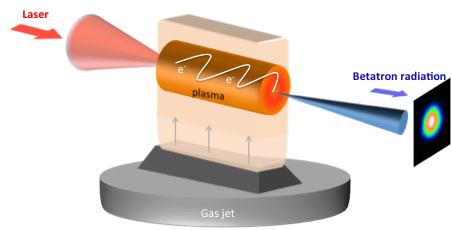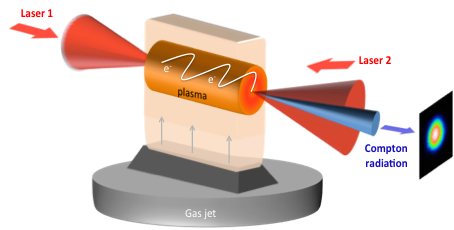Relativistic interaction of short-pulse lasers with underdense plasmas has recently led to the emergence of a novel generation of femtosecond X-ray sources. Based on radiation from electrons accelerated in plasma, these sources have the necessary properties to be compact and to deliver collimated, incoherent, and femtosecond radiation.
With recent developments, laser systems can deliver focused intensities above 1018 W/cm2, and the laser-plasma interaction has entered the relativistic regime [1]. At this light intensity, relativistic effects become significant. Electrons can be accelerated within the laser field or in the wakefield of the laser up to relativistic energies. In particular, laser wakefield acceleration has led to the production of high-quality femtosecond relativistic electron bunches, created and accelerated up to the GeV level within plasma measuring only a few millimeters or centimeters [2, 3, 4, 5, 6]. Using these relativistic electrons, several novel X-ray source schemes have been proposed over the past decades to produce collimated and femtosecond radiation in a spectrum ranging from soft X-rays to gamma rays [7]. Most of these schemes are based on the wiggling of relativistic electrons accelerated in a laser wakefield [8, 9]. These sources can deliver X-rays or gamma rays as short as a few femtoseconds, as they inherit the temporal profile of the laser-plasma electron bunch, the few-femtosecond duration of which was recently demonstrated experimentally [10].


Figure 1. Schematic description of electrons producing Betatron radiation in a laser plasma accelerator (left) and Compton scattering radiation (right).
Based on these processes, two X-ray beamlines will be built in the E2 experimental hall.
References:
[1] Umstadter, D., 2003, J. Phys. D 36, R151; Mourou, G. A., T. Tajima, and S. V. Bulanov, 2006, Rev. Mod. Phys. 78, 309.
[2] Tajima, T., and J. M. Dawson, 1979, Phys. Rev. Lett. 43, 267.
[3] Joshi, C., et al., 1984, Nature (London) 311, 525.
[4] Faure, J., et al., 2006, Nature (London) 444, 737.
[5] Mangles et al., 2004, Nature (London) 431, 535.
[6] Leemans et al., 2006, Nat. Phys. 2, 696.
[7] Catravas et al., 2001, Meas. Sci.Technol. 12, 1828.
[8] Grüner et al., Phys. Rev. ST Accel. Beams 12, 020701.
[9] Kneip, S., et al., 2010, Nat. Phys. 6, 980.
[10] Lundh, O., et al., 2011, Nat. Phys. 7, 219
Kim Ta Phuoc
Postdocotoral scientist
Uddhab Chaulagain
PhD students
Karel Bohacek
Vojtech Horny
Undergraduate students
Tomas Kerepecky
Jakub Vancura





